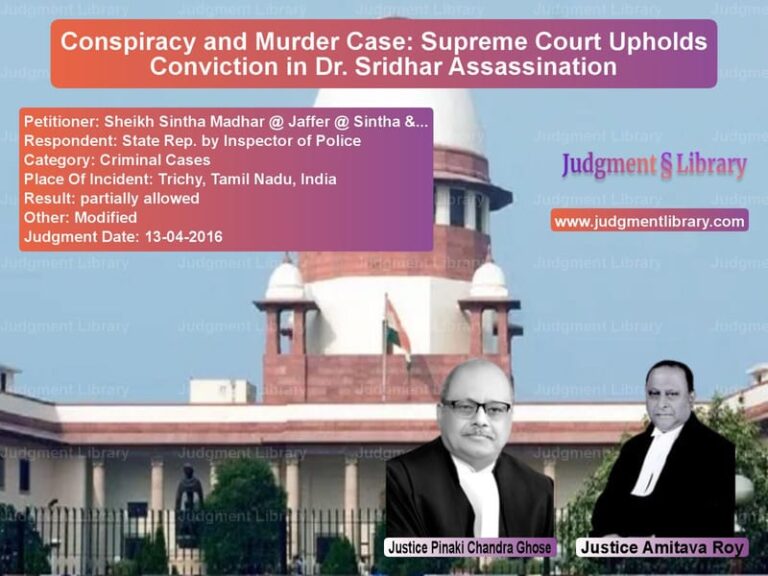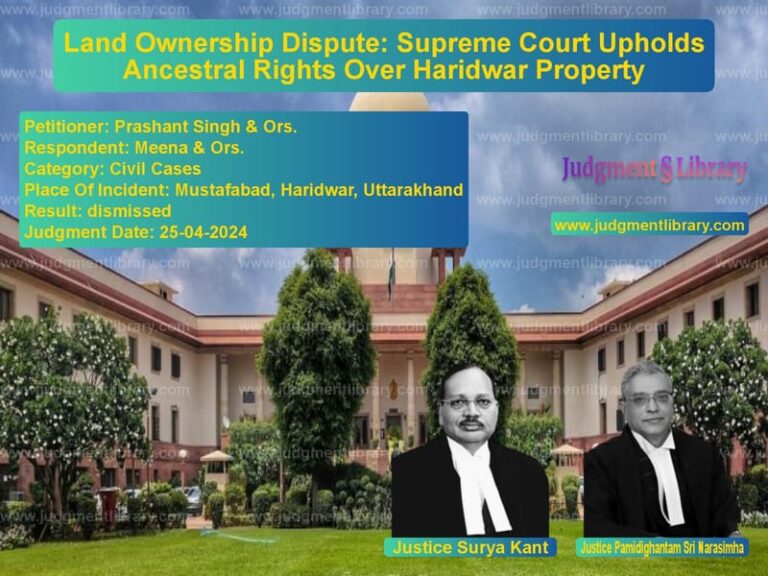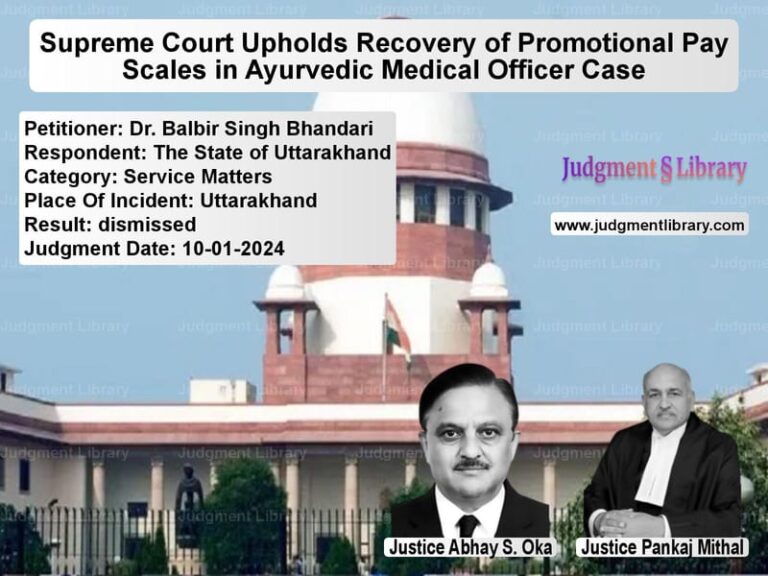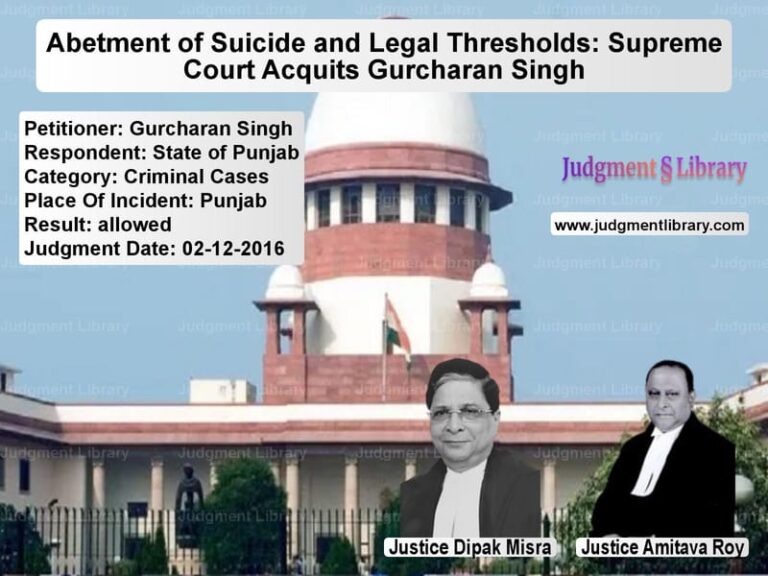Supreme Court Dismisses Writ Petition on Judicial Appointment: Clarifies Eligibility Under Article 217
The case of R. Poornima & Ors. vs. Union of India & Ors. revolves around the eligibility of judicial officers for elevation to the High Court under Article 217 of the Constitution of India. The Supreme Court was called upon to determine whether the petitioners, who were appointed as District Judges through direct recruitment, could combine their years of practice as advocates with their judicial service to meet the ten-year eligibility criteria for High Court appointment.
The petitioners, who were senior-most in the District Judge cadre in Tamil Nadu, challenged the exclusion of their names from the list of candidates recommended for elevation to the Madras High Court. They contended that their years of practice before joining the judiciary should be considered while determining their eligibility under Article 217(2) of the Constitution. The Supreme Court, however, dismissed the petition, ruling that judicial officers must complete ten years of judicial service independently to qualify under Article 217(2)(a) and cannot combine prior legal practice.
Background of the Case
The petitioners were directly recruited as District Judges (Entry Level) in Tamil Nadu through a Government Order (G.O. Ms. No. 170, Home Department) dated February 18, 2011. At the time of their recruitment:
- Petitioners 1 to 6 had practiced as advocates for more than ten years before joining the judiciary.
- Petitioner 7 had practiced for nine years and ten months.
- Petitioner 8 had practiced for eight years and six months.
They claimed that despite being senior-most in the District Judge cadre, their names were not considered for elevation to the High Court, while their juniors were recommended. They argued that the High Court’s Collegium wrongly interpreted Article 217(2) by considering only judicial service and disregarding prior legal practice.
Petitioner’s Arguments
The petitioners contended:
- Article 217(2) should be interpreted to allow the clubbing of legal practice and judicial service to meet the ten-year requirement.
- They were senior-most among District Judges and were unfairly overlooked for elevation.
- Explanation (a) under Article 217(2) allows the inclusion of legal practice in computing judicial experience.
- The precedent in P. Ramakrishnam Raju vs. Union of India (2014) 12 SCC 1, where legal practice was counted for pension purposes, should apply to eligibility as well.
- Past instances of judges being appointed by combining legal practice and judicial service were wrongly disregarded.
Respondent’s Arguments
The Union of India and the Collegium of the High Court argued:
- Article 217(2)(a) explicitly requires ten years of judicial service for judicial officers seeking High Court elevation.
- Legal practice can be considered only under Article 217(2)(b), which applies to advocates, not judicial officers.
- The High Court correctly followed established constitutional principles in determining eligibility.
- Allowing the clubbing of service and practice would create an unfair advantage over other judicial officers.
- The decision in Dheeraj Mor vs. High Court of Delhi (2020) 4 SCC 619 clarified that judicial officers must complete ten years of service separately.
Supreme Court’s Key Observations
The Supreme Court carefully examined the constitutional provisions and precedents governing High Court appointments. It made the following key observations:
“The queue to which a person is assigned depends upon his status on the date of consideration. A judicial officer must complete ten years in judicial service. He cannot claim benefits from legal practice.”
The Court further noted:
- Article 217(2) provides two distinct routes for High Court appointment: (a) ten years of judicial service or (b) ten years as an advocate.
- Explanation (a) under Article 217(2) allows prior legal practice to be counted only if the person left judicial service and became an advocate.
- Once a person joins judicial service, they cannot simultaneously benefit from both categories.
- In Dheeraj Mor, the Court ruled that judicial officers must meet eligibility under Article 217(2)(a) independently.
- Allowing a mix of judicial service and legal practice would create an unequal playing field among judicial officers.
Legal Precedents Considered
The Supreme Court relied on several important precedents:
- Dheeraj Mor vs. High Court of Delhi (2020) 4 SCC 619: Clarified that judicial officers must meet the ten-year service requirement separately.
- P. Ramakrishnam Raju vs. Union of India (2014) 12 SCC 1: Addressed pension computation, but the Court ruled that it was irrelevant to eligibility.
- Mahesh Chandra Gupta vs. Union of India (2009) 8 SCC 273: Defined the qualifications for judicial appointments.
- Shri Kumar Padma Prasad vs. Union of India (1992) 2 SCC 428: Held that only members of the judicial service are eligible under Article 217(2)(a).
Final Judgment
The Supreme Court dismissed the writ petition, ruling:
“The petitioners, having been recruited as District Judges, must meet the eligibility criteria under Article 217(2)(a). They cannot claim eligibility under both clauses simultaneously. The High Court’s decision was correct.”
The Court held that judicial officers cannot combine their years of legal practice with judicial service to fulfill the ten-year requirement for High Court appointments.
Implications of the Judgment
This ruling has significant implications for judicial appointments:
- It reinforces that judicial officers must meet the eligibility criteria for elevation under Article 217(2)(a) independently.
- It clarifies that legal practice cannot be combined with judicial service for High Court eligibility.
- It upholds the principle that once a person enters judicial service, they must meet eligibility as a judicial officer.
- It prevents confusion and ensures consistency in judicial appointments.
- It aligns with previous Supreme Court rulings that discourage switching between judicial and legal categories.
With this judgment, the Supreme Court has provided clarity on the eligibility criteria for High Court appointments, ensuring a fair and structured process for judicial elevations.
Petitioner Name: R. Poornima & Ors..Respondent Name: Union of India & Ors..Judgment By: Justice S.A. Bobde, Justice A.S. Bopanna, Justice V. Ramasubramanian.Place Of Incident: Tamil Nadu.Judgment Date: 04-09-2020.
Don’t miss out on the full details! Download the complete judgment in PDF format below and gain valuable insights instantly!
Download Judgment: R. Poornima & Ors. vs Union of India & Ors Supreme Court of India Judgment Dated 04-09-2020.pdf
Direct Downlaod Judgment: Direct downlaod this Judgment
See all petitions in Public Interest Litigation
See all petitions in Constitution Interpretation
See all petitions in Legislative Powers
See all petitions in Judgment by S. A. Bobde
See all petitions in Judgment by A. S. Bopanna
See all petitions in Judgment by V. Ramasubramanian
See all petitions in dismissed
See all petitions in supreme court of India judgments September 2020
See all petitions in 2020 judgments
See all posts in Constitutional Cases Category
See all allowed petitions in Constitutional Cases Category
See all Dismissed petitions in Constitutional Cases Category
See all partially allowed petitions in Constitutional Cases Category







